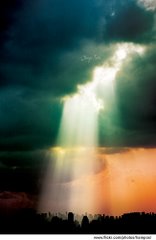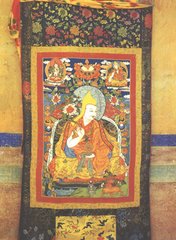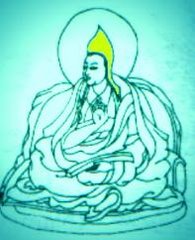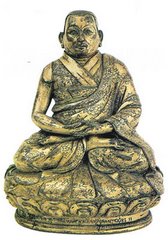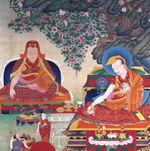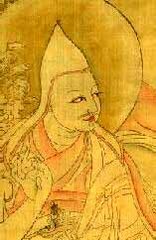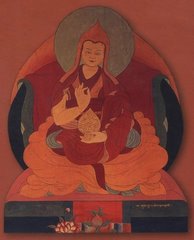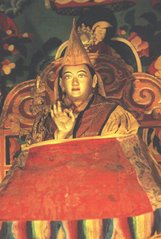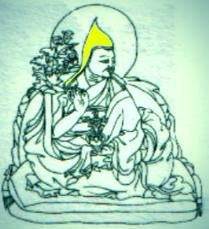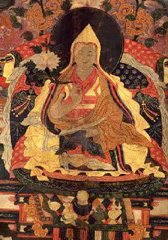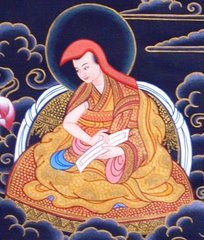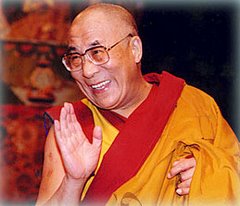Saturday, March 24, 2007
The Dalai Lama
The Dalai Lama is considered the supreme head of Tibetan Buddhism and, until 1959, was the head of Tibetan government. The Dalai Lama is believed to be a reincarnation of the Buddha. When he dies, his soul is thought to enter the body of a newborn boy, who becomes the new Dalai Lama. The successive Dalai Lamas form a lineage of supposedly reborn magistrates which traces back to 1391. Tibetans call the Dalai Lama Gyalwa Rinpoche meaning "Precious Victor," or Yishin Norbu meaning "Wish-fulfilling Jewel".
Residence of the Dalai Lamas

Starting with the 5th Dalai Lama and until the 14th Dalai Lama's flight into exile in 1959, the Dalai Lamas lived at the Potala Palace during winter, and at the Norbulingka Palace and Park in the summer. Both places are in Lhasa, Tibet. Since 1959, the Dalai Lama has been in refuge in the state of Himachal Pradesh in northern India, where the Central Tibetan Administration is recognized.
Origin of the Name "Dalai Lama"
In Mongolian, "Dalai" means "ocean" and "Lama" is equivalent to the Tibetan word "guru." So "Dalai Lama" is commonly translated to mean "spiritual teacher". The actual title was first given to Sonam Gyatso, the 3rd Dalai Lama, by the Mongolian ruler Altan Khan in 1578. Although Sonam Gyatso was the first Lama to hold the name of the "Dalai Lama," he actually became known as the 3rrd Dalai Lama because he was the third member of his lineage.
Succession of Reborn Dalai Lamas
The title “Dalai Lama” is the name given to each of the spiritual leader's successive incarnations. For example, The 14th Dalai Lama's next incarnation will hold the title “the 15th Dalai Lama”.
Upon the death of the Dalai Lama, his monks organize a search for the Lama's reincarnation. Familiarity with the possessions of the previous Dalai Lama is considered the main sign of the reincarnation. The process of searching for the reincarnation typically requires a few years. The reincarnation is then brought to Lhasa to be trained by the other Lamas.
Upon the death of the Dalai Lama, his monks organize a search for the Lama's reincarnation. Familiarity with the possessions of the previous Dalai Lama is considered the main sign of the reincarnation. The process of searching for the reincarnation typically requires a few years. The reincarnation is then brought to Lhasa to be trained by the other Lamas.
The 14th Dalai Lama

Tenzin Gyatso is 14th and current Dalai Lama. He was born on July 6th, 1935 in the Tibetan province of Amdo. He is the fifth of sixteen children and was proclaimed the tulku (rebirth) of the thirteenth Dalai Lama, Thubten Gyatso, when he was two. On November 17th, 1950, when he was 15, he was established as the Tibet's Head of State and most important political ruler. He is the first Dalai Lama to ever travel to the West and spread Buddhism. In 1959, Tenzin Gyatso left Tibet due to an unsuccessful rebellion with the Chinese Communists and thereafter lived in India. In 1989 Tenzin Gyatso receiced the Nobel Peace Price for the nonviolent opposition to the Chinese rule in Tibet.
Tenzin Gyatso's Discovery

Tenzin Gyatso was raised in a farming community in northeastern Amdo in the village of Taktser. He had 15 siblings and his parents Choekyong and Diki Tsering. They were reasonably wealthy farmers making a living off of the land raising barley, buckwheat, and potatoes.
When he was two, there was a search party sent out to find the new incarnation of the Dalai Lama. One hint which indicated the direction in which the next Dalai Lama would be found was shown when the embalmed body of the 13th Dalai Lama, Thubten Gyatso, had mysteriously turned to face the northeast direction when it was originally facing the south. Another sign was when Regent Reting Rinpoche had a vision of a one-story house in Amdo. After much searching, they found a house that Reting’s vision. They then presented each of the younger children in the house with various toys, some belonging to the previous Dalai Lama, some not. Tenzin Gyatso immediately identified the toys owned by the previous Dalai Lama and stated “It’s mine! It’s mine!”
After this occurrence, Tenzin Gyatso was recognized as the rebirth of the Dalai Lama. In the West, he is often refered to as “His Holiness the Dalai Lama”. Tenzin Gyatso began his education at the age of six. At age 15, he was inaugurated as Tibet's Head of State.
Three Main Commitments in Life
Firstly, on the level of a human being, His Holiness’ first commitment is the promotion of human values such as compassion, forgiveness, tolerance, contentment and self-discipline. All human beings are the same. We all want happiness and do not want suffering. Even people who do not believe in religion recognize the importance of these human values in making their life happier. His Holiness refers to these human values as secular ethics. He remains committed to talk about the importance of these human values and share them with everyone he meets.
Secondly, on the level of a religious practitioner, His Holiness’ second commitment is the promotion of religious harmony and understanding among the world’s major religious traditions. Despite philosophical differences, all major world religions have the same potential to create good human beings. It is therefore important for all religious traditions to respect one another and recognize the value of each other’s respective traditions. As far as one truth, one religion is concerned, this is relevant on an individual level. However, for the community at large, several truths, several religions are necessary.
Thirdly, His Holiness is a Tibetan and carries the name of the ‘Dalai Lama’. Tibetans place their trust in him. Therefore, his third commitment is to the Tibetan issue. His Holiness has a responsibility to act as the free spokesperson of the Tibetans in their struggle for justice. As far as this third commitment is concerned, it will cease to exist once a mutually beneficial solution is reached between the Tibetans and Chinese.
However, His Holiness will carry on with the first two commitments till his last breath.
Quoted from the Official Website of the 14th Dalai Lama
Secondly, on the level of a religious practitioner, His Holiness’ second commitment is the promotion of religious harmony and understanding among the world’s major religious traditions. Despite philosophical differences, all major world religions have the same potential to create good human beings. It is therefore important for all religious traditions to respect one another and recognize the value of each other’s respective traditions. As far as one truth, one religion is concerned, this is relevant on an individual level. However, for the community at large, several truths, several religions are necessary.
Thirdly, His Holiness is a Tibetan and carries the name of the ‘Dalai Lama’. Tibetans place their trust in him. Therefore, his third commitment is to the Tibetan issue. His Holiness has a responsibility to act as the free spokesperson of the Tibetans in their struggle for justice. As far as this third commitment is concerned, it will cease to exist once a mutually beneficial solution is reached between the Tibetans and Chinese.
However, His Holiness will carry on with the first two commitments till his last breath.
Quoted from the Official Website of the 14th Dalai Lama
Words of Truth
A Prayer Composed by
His Holiness Tenzin Gyatso, the Fourteenth Dalai Lama of Tibet
Honoring and Invoking the Great Compassion
of the Three Jewels; the Buddha, the Teachings,
and the Spiritual Community
O Buddhas, Bodhisattvas, and disciples
of the past, present, and future:
Having remarkable qualities
Immeasurably vast as the ocean,
Who regard all helpless sentient beings
as your only child;
Please consider the truth of my anguished pleas.
Buddha's full teachings dispel the pain of worldly
existence and self-oriented peace;
May they flourish, spreading prosperity and happiness through-
out this spacious world.
O holders of the Dharma: scholars
and realized practitioners;
May your ten fold virtuous practice prevail.
Humble sentient beings, tormented
by sufferings without cease,
Completely suppressed by seemingly endless
and terribly intense, negative deeds,
May all their fears from unbearable war, famine,
and disease be pacified,
To freely breathe an ocean of happiness and well-being.
And particularly the pious people
of the Land of Snows who, through various means,
Are mercilessly destroyed by barbaric hordes
on the side of darkness,
Kindly let the power of your compassion arise,
To quickly stem the flow of blood and tears.
Those unrelentingly cruel ones, objects of compassion,
Maddened by delusion's evils,
wantonly destroy themselves and others;
May they achieve the eye of wisdom,
knowing what must be done and undone,
And abide in the glory of friendship and love.
May this heartfelt wish of total freedom for all Tibet,
Which has been awaited for a long time,
be spontaneously fulfilled;
Please grant soon the good fortune to enjoy
The happy celebration of spiritual with temporal rule.
O protector Chenrezig, compassionately care for
Those who have undergone myriad hardships,
Completely sacrificing their most cherished lives,
bodies, and wealth,
For the sake of the teachings, practitioners,
people, and nation.
Thus, the protector Chenrezig made vast prayers
Before the Buddhas and Bodhisativas
To fully embrace the Land of Snows;
May the good results of these prayers now quickly appear.
By the profound interdependence of emptiness
and relative forms,
Together with the force of great compassion
in the Three Jewels and their Words of Truth,
And through the power
of the infallible law of actions and their fruits,
May this truthful prayer be unhindered
and quickly fulfilled.
His Holiness Tenzin Gyatso, the Fourteenth Dalai Lama of Tibet
Honoring and Invoking the Great Compassion
of the Three Jewels; the Buddha, the Teachings,
and the Spiritual Community
O Buddhas, Bodhisattvas, and disciples
of the past, present, and future:
Having remarkable qualities
Immeasurably vast as the ocean,
Who regard all helpless sentient beings
as your only child;
Please consider the truth of my anguished pleas.
Buddha's full teachings dispel the pain of worldly
existence and self-oriented peace;
May they flourish, spreading prosperity and happiness through-
out this spacious world.
O holders of the Dharma: scholars
and realized practitioners;
May your ten fold virtuous practice prevail.
Humble sentient beings, tormented
by sufferings without cease,
Completely suppressed by seemingly endless
and terribly intense, negative deeds,
May all their fears from unbearable war, famine,
and disease be pacified,
To freely breathe an ocean of happiness and well-being.
And particularly the pious people
of the Land of Snows who, through various means,
Are mercilessly destroyed by barbaric hordes
on the side of darkness,
Kindly let the power of your compassion arise,
To quickly stem the flow of blood and tears.
Those unrelentingly cruel ones, objects of compassion,
Maddened by delusion's evils,
wantonly destroy themselves and others;
May they achieve the eye of wisdom,
knowing what must be done and undone,
And abide in the glory of friendship and love.
May this heartfelt wish of total freedom for all Tibet,
Which has been awaited for a long time,
be spontaneously fulfilled;
Please grant soon the good fortune to enjoy
The happy celebration of spiritual with temporal rule.
O protector Chenrezig, compassionately care for
Those who have undergone myriad hardships,
Completely sacrificing their most cherished lives,
bodies, and wealth,
For the sake of the teachings, practitioners,
people, and nation.
Thus, the protector Chenrezig made vast prayers
Before the Buddhas and Bodhisativas
To fully embrace the Land of Snows;
May the good results of these prayers now quickly appear.
By the profound interdependence of emptiness
and relative forms,
Together with the force of great compassion
in the Three Jewels and their Words of Truth,
And through the power
of the infallible law of actions and their fruits,
May this truthful prayer be unhindered
and quickly fulfilled.
Subscribe to:
Posts (Atom)
